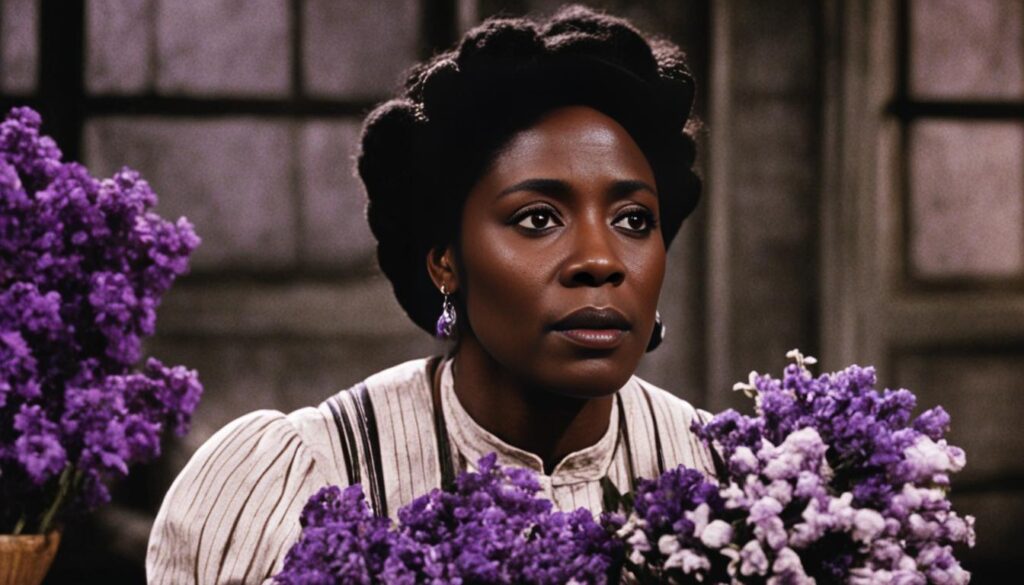Alice Walker’s novel, The Color Purple, continues to captivate readers with its powerful storytelling, profound themes, and deep characters. First published in 1982, the novel has since become a literary masterpiece and has received numerous awards. In this section, we will provide an overview of the significance of The Color Purple as a novel and delve into our audiobook review for those who prefer listening to reading books.
The Color Purple explores the themes of racism, sexism, oppression, and abuse, highlighting the resilience of the human spirit under these weighty issues. The novel’s protagonist, Celie, gives voice to the marginalized Black women who have been historically deprived of their rights and dignity.
Throughout this article, we will discuss the book’s historical context, literary elements, character analysis, themes, and cultural impact that make it a must-read for all. Whether you have read the book or not, we offer an audiobook review that gives a deeper insight into the novel’s story, characters, and messages while offering a contemporary mode of literary consumption.
Plot Summary of “The Color Purple”
Set in the early 1900s, “The Color Purple” follows the life of Celie, a young African American girl who suffers abuse and oppression from men throughout her life. Through a series of letters to God and her sister, Nettie, Celie navigates her way through a world that is hostile and unkind, finding strength in herself and the women who support her.
The novel explores powerful themes of identity, love, and triumph, as Celie learns to love and value herself despite the atrocities she has faced. Along the way, she meets inspiring characters such as Sofia, a strong-willed woman who refuses to be defeated by her circumstances, and Shug Avery, a talented singer who teaches Celie about self-discovery and sexuality.
The story takes place in Georgia and Africa, showcasing the different settings and cultures that influence Celie’s life. Through her journey, readers gain insight into the complex intersectionality of race, gender, and class in American society at the time.
“The Color Purple” is an emotional and thought-provoking novel that leaves a lasting impact on readers long after they finish the last page.
Historical Context of “The Color Purple”
To fully appreciate “The Color Purple,” it is essential to explore the historical context surrounding its creation. Set in the 1930s rural South, the novel depicts the experiences of African American women during a time when segregation and systemic oppression were commonplace.
Writer Alice Walker drew on her own family’s history to inform the novel’s characters and narratives, but she also infused the work with broader themes that spoke to the political and social realities of the era. Through the eyes of its protagonist, Celie, “The Color Purple” highlights critical issues such as domestic violence, racism, and gender inequality.
At the time of its publication in 1982, “The Color Purple” was groundbreaking in its portrayal of the underrepresented voices of African American women. Through its ambitious scope and powerful prose, the novel helped to reshape the literary landscape and spark a new wave of feminist and minority writing.
“I think us here to wonder, myself. To wonder. To ask. And that in wondering bout the big things and asking bout the big things, you learn about the little ones, almost by accident. But you never know nothing more about the big things than you start out with. The more I wonder, the more I love.”
Themes Explored in “The Color Purple”
At its core, “The Color Purple” is a deeply resonant exploration of some of the most profound themes that make us human. Alice Walker imbues her novel with powerful messages about love, resilience, and the human experience that have captivated readers for decades. Through the struggles and triumphs of her characters, Walker invites readers to reflect on their own lives and to confront some of life’s most complex questions.
One of the key themes in “The Color Purple” is the resilience of the human spirit. Throughout the novel, we witness characters who face unspeakable adversity and yet, through sheer force of will, manage to overcome the obstacles they encounter along the way. Celie, the novel’s protagonist, is a powerful embodiment of this theme. Although she endures unimaginable trauma, Celie never loses her will to survive, ultimately emerging as a strong and capable woman who refuses to let others define her worth.
Another important theme in “The Color Purple” is the importance of community. Walker highlights the value of the relationships we form with others, illustrating how they can shape and enrich our lives in numerous ways. Shug Avery, one of the key characters in the novel, serves as a symbol of the transformative power of connection, as she helps Celie discover her voice and her own sense of self-worth.
Self-discovery is yet another theme that resonates deeply throughout “The Color Purple.” Walker’s characters are constantly grappling with questions about their identities, seeking to understand who they are and what they stand for in a world that often seeks to diminish their sense of self. As we witness their journeys of self-discovery, we are prompted to reflect on our own sense of identity and what it means to truly know ourselves.
Indeed, “The Color Purple” is a rich tapestry of themes that weave together to create a story that is both timeless and universal. Its themes remind us of the importance of compassion, empathy, and a willingness to confront the issues that shape our world. Through its powerful words and emotive storytelling, “The Color Purple” continues to resonate with readers of all backgrounds and remains a cultural touchstone in American literature.
Character Analysis in “The Color Purple”
One of the most compelling aspects of “The Color Purple” is its richly developed cast of characters. This section offers an in-depth character analysis of the key players in the novel and how they contribute to its overarching themes and narrative.
Celie
Celie is the protagonist of “The Color Purple,” and her journey towards self-discovery and empowerment is central to the novel’s plot. She initially appears timid and submissive, having suffered abuse and trauma since childhood. However, as the story progresses, Celie develops a deeper sense of self-worth and independence. Her character arc illustrates the transformative power of community and love.
Shug Avery
Shug Avery, a popular blues singer, enters Celie’s life and proves to be a catalyst for her growth. Shug is unapologetically herself and challenges Celie’s previously held beliefs about femininity and sexuality. Their relationship is a crucial aspect of the novel’s exploration of queer love and identity.
Mr. ____
Mr. ____ is Celie’s abusive husband, who initially embodies the oppressive patriarchal societal norms of the time. However, throughout the novel, Mr. ____ undergoes his own transformation, realizing the harm he has caused and attempting to make amends. His character highlights the potential for growth and change, even in individuals who seem irredeemable.

“The Color Purple” is a true masterpiece of character development. Each character is so intricately crafted and serves as a symbol for the larger themes explored in the novel.
Through the character analysis of Celie, Shug Avery, and Mr. ____, we gain a deeper understanding of not only their individual motivations and growth but also the overarching societal forces that shape their experiences. “The Color Purple” is a novel that reminds us of the power of change and growth, both on a personal and societal level.
Literary Elements in “The Color Purple”
As an acclaimed author, Alice Walker has skillfully employed literary elements to convey her message in the novel “The Color Purple.” One such element that stands out is symbolism. Throughout the novel, the color purple is used to represent a range of emotions, from sadness and pain to freedom and joy. Walker also uses sound imagery to create a sense of the characters’ worlds, with prominent examples including the way Celie’s letters to God open with the salutation “Dear God,” which highlights her sense of abandonment and emotional isolation.
Another literary element in “The Color Purple” is narrative structure. The novel’s epistolary form reflects the genre of slave narratives and allows for a more intimate connection between the reader and the characters. Additionally, the use of multiple narrators and perspectives provides a nuanced look at the characters’ experiences and feelings.
Furthermore, dialogue plays a pivotal role in character development and plot advancement in this novel. Celie’s voice, in particular, evolves throughout the story, and her relationships with other characters are explored through dialogue.
“…you have to fight them. You have to fight them,” said Sofia in Chapter 10, which highlights her fighting spirit and determination to speak up against oppression.
Overall, these literary elements in “The Color Purple” contribute to the novel’s emotional depth and social commentary. They help to create an immersive experience for the reader, showcasing the power of Walker’s writing style.
Cultural Impact of “The Color Purple”
The impact of “The Color Purple” extends far beyond its literary success. Since its publication in 1982, the novel has had a profound cultural impact on society.
One of the most significant impacts of the book is the increased visibility and representation of African American women in literature. The novel brings to light the struggles faced by this group and offers a powerful portrayal of their experiences.
“The Color Purple” is a groundbreaking work that challenges readers to confront issues of race, gender, and identity. It has had a transformative impact not only on literature but also on society as a whole.
The book has also been adapted into various forms of media, including a film and a Broadway musical. These adaptations have helped to further amplify the novel’s message and reach wider audiences.
In popular culture, “The Color Purple” has also become a reference point for empowering women and marginalized communities. Its themes of resilience, self-discovery, and community have inspired countless readers.
Overall, the cultural impact of “The Color Purple” can hardly be overstated. Its influence continues to reverberate throughout literature, media, and society at large.
Audiobook Narration and Production
“The Color Purple” audiobook version is a feast for the ears. Narrator Alice Walker lends her voice to the story’s protagonist, Celie, and expertly captures the dialect and tone of the Deep South in the early 20th century. Her narration style is slow and deliberate, allowing listeners to savor each word, sentence, and passage. The production of the audiobook is top-notch, with high-quality sound and seamless editing.
Listeners will appreciate the audiobook’s immersive experience of “The Color Purple.” Whether you’re in the car, folding laundry, or just kicking back with a cup of tea, the audiobook transports you to the heart of the story. You’ll feel the triumphs and setbacks of the characters in a way that only good storytelling can achieve.
Overall, the audiobook version of “The Color Purple” is a remarkable accomplishment. The narration and production quality make it a pleasure to listen to, and the immersive experience will leave you feeling deeply moved.
Reception and Reviews of the Audiobook
Since its release, the audiobook adaptation of “The Color Purple” has garnered significant attention and critical praise. Listeners have praised the narration style and production quality of the audiobook, which enhances the emotional journey of the novel.
According to The New York Times Book Review, “The Color Purple” audiobook is a “gripping and heartwarming book that holds the listener even when the story itself falters.” The audiobook also received a 4.4-star rating on Audible, with users commending the performances of the voice actors and the powerful storytelling of the novel.
“The audiobook version of ‘The Color Purple’ is a true masterpiece. The narrators do an excellent job bringing the characters to life and immersing the listener into the story. I highly recommend listening to this audiobook!” -Audible review
Despite the widespread acclaim, some listeners have criticized the audiobook for its length and pacing. Several reviews on Goodreads noted that the narration felt slow and dragged on at times, making it difficult to maintain interest in the story.
Comparison to Print Version
Compared to the print version, the audiobook of “The Color Purple” offers a unique experience that amplifies certain aspects of the novel. Through the narrator’s voice, listeners are able to better connect with the characters’ emotions and inner monologues.
However, some readers find that the audiobook misses the visual impact of the written text and may not capture the nuances of language and dialect as well as the printed version.
Listener Recommendations and Criticisms
Based on listener feedback, we compiled a list of recommendations and criticisms of the audiobook of “The Color Purple.”
Recommendations:
- The voice actors did an excellent job capturing the nuances of each character.
- The audiobook is a powerful way to experience the emotions and themes of the novel.
Criticisms:
- The narration can be slow and monotonous at times.
- The use of different actors for each character can be distracting.

Comparisons to the Print Version
While the audiobook of “The Color Purple” offers a unique listening experience, there are notable differences when compared to the print version. One of the main distinctions is in the portrayal of dialects and accents.
In the print version, the characters’ dialects and accents are presented primarily through dialogue, with some phonetic spellings to indicate pronunciation. However, in the audiobook, the dialects and accents are pronounced aloud by the narrator, adding a new layer to the characters’ voices.
Another difference is in the pacing of the story. While readers have control over the speed at which they read the print version, the audiobook has a set pace dictated by the narrator. As a result, the listening experience can feel slower or faster than the reading experience, depending on the listener’s preferences.
Furthermore, the audiobook includes additional audio elements that can enhance the listener’s immersion in the story. These elements may include music, sound effects, or different narrator voices for different characters. However, these additional elements may not be present in the print version.
Overall, both the print version and the audiobook offer their own unique ways of experiencing “The Color Purple.” While the print version allows for more control over the reading experience, the audiobook offers a new dimension to the characters’ voices and includes additional audio elements. Ultimately, the choice between the two versions depends on personal preference and the listener’s goals.
Listener Recommendations and Criticisms
At the heart of any audiobook is the listening experience. We’ve sifted through listener recommendations and criticisms to bring you a nuanced overview.
| Listener Recommendations: | Criticisms: |
|---|---|
| The narration by actress Whoopi Goldberg is heart-rending and powerful. | Some listeners found Goldberg’s portrayal of male characters to be less convincing than her female voices. |
| The audiobook brings added depth and emotion to the novel’s already profound storyline. | Others felt that the audiobook’s heavy themes and subject matter made it difficult to listen to for extended periods. |
| The audio production quality is exceptional, with clear sound and voice. | Some listeners felt that the audiobook was too condensed and lacked the same level of detail as the print version. |
| The audiobook provides a fresh and immersive way to experience the novel. | Those who were unfamiliar with African American dialects found it challenging to follow certain passages. |
Overall, listener recommendations attest to the emotional impact and power of the audiobook rendition of “The Color Purple.” While some criticisms exist around the narration and pacing, the majority of listeners agree that it is a worthy and enriching rendition of a beloved literary classic.
Impact and Legacy of “The Color Purple”
Since its publication in 1982, “The Color Purple” has had a significant impact and continued to leave a lasting legacy in both the literary world and society. The novel’s unflinching portrayal of the struggles and triumphs of African American women in the early 20th century opened up new conversations regarding race, gender, and identity.
The legacy of “The Color Purple” is evident from the numerous awards and critical acclaim it has received over the years, including the Pulitzer Prize for Fiction in 1983 and the National Book Award for Fiction in 1983. The novel has been translated into over 25 languages and adapted into a film and a Broadway musical, solidifying its place in popular culture.
Walker’s work has also inspired a new generation of writers and activists, who continue to draw upon its themes and messages to advocate for social justice. “The Color Purple” has become a pivotal text in the study of African American literature, informing and inspiring scholarly conversations and debates.
The Color Purple: A Cultural Touchstone
In her own words, Alice Walker hoped that her novel would “be read by people of all colors, all ages, all sexual orientations.” Her wish has come true, as “The Color Purple” has had a profound impact on readers and listeners from all walks of life.
“I read ‘The Color Purple’ for the first time as a young black woman and felt seen and heard in a way that I never had before. It gave me the courage to own my own story and embrace my identity.” – Tiffany H., 32, Atlanta
The compelling characters, evocative settings, and emotional trajectory of the novel resonate with audiences worldwide, connecting them to the struggles and experiences of African American women and their communities. “The Color Purple” has become much more than just a book or an audiobook; it is a cultural touchstone that speaks to the human experience and the importance of empathy, love, and resilience.
Conclusion
Overall, “The Color Purple” audiobook offered an immersive and engaging listening experience that highlighted the strengths of the original novel. With its richly developed characters, powerful themes, and evocative prose, Alice Walker’s masterpiece continues to resonate with readers and listeners alike.
The narration and production of the audiobook were of high quality, bringing the story to life in a way that remained true to the source material while still offering a fresh and unique perspective.
Although there were some minor criticisms regarding certain aspects of the audiobook, such as the pacing or the performance of certain characters, the majority of listeners found it to be a compelling and rewarding experience.
Ultimately, “The Color Purple” remains a timeless work of literature that continues to inspire and challenge audiences decades after its initial publication. Whether read in print or listened to in audiobook form, this iconic novel belongs on every bookshelf and in every collection.



